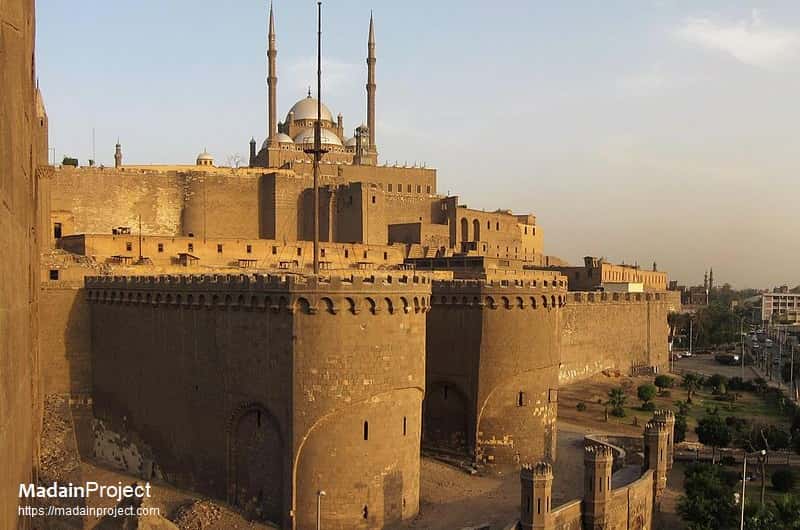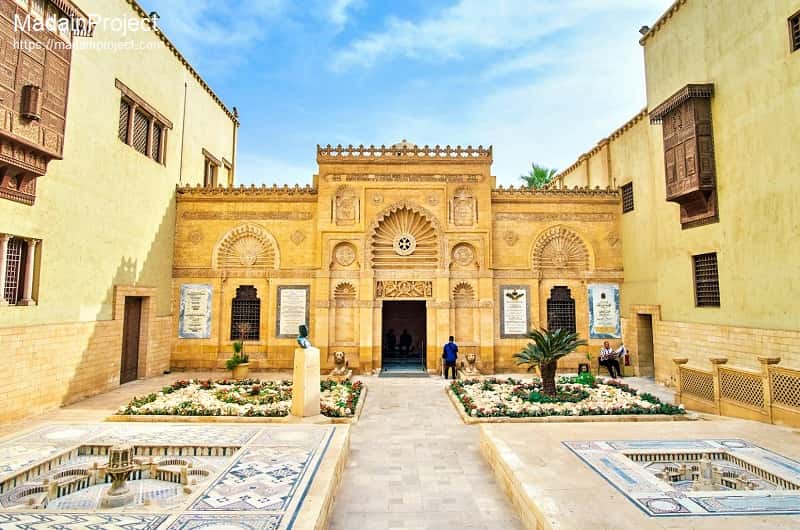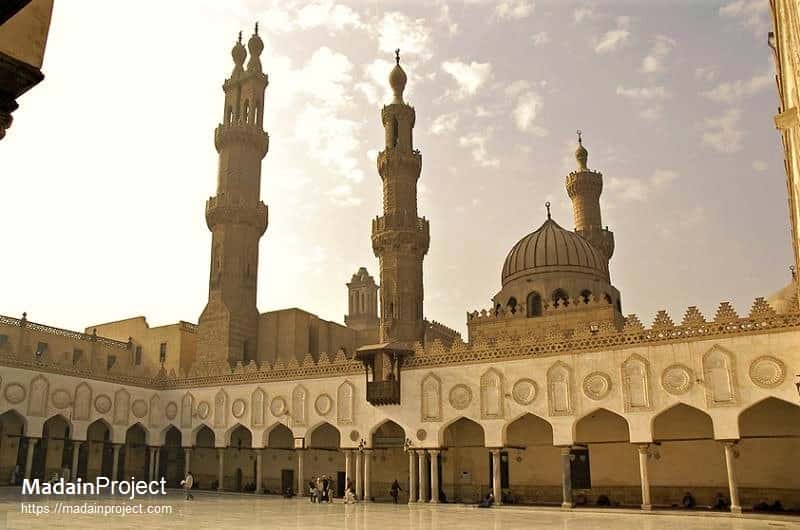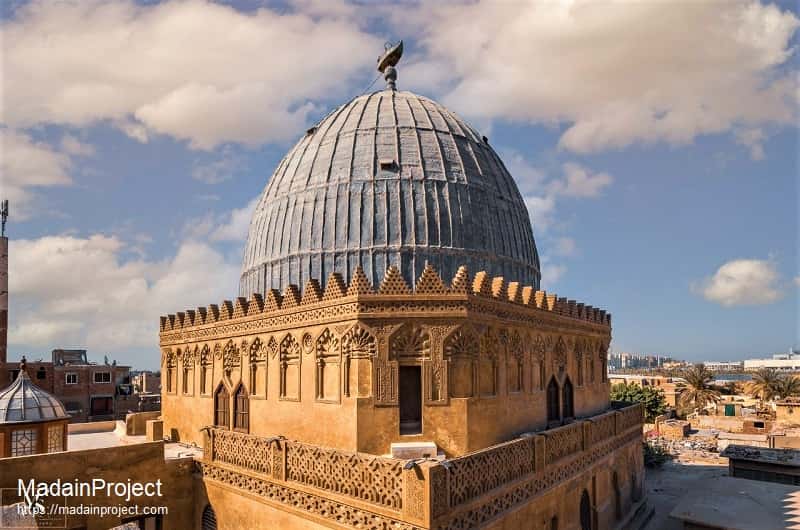The historic city of Cairo (القاهرة) is the capital of Egypt and the largest city in the Arab world. Cairo is associated with ancient Egypt, as the Giza pyramid complex and the ancient city of Memphis are located in its geographical area. Located near the Nile Delta, Cairo was founded in 969 CE during the Fatimid dynasty. Cairo is also home to the world's second-oldest institution of higher learning, al-Azhar University.
Cairo’s history can be traced back to the ancient period through its proximity to the earlier city of Memphis, founded circa 3100 BCE during Egypt’s Early Dynastic period. Memphis was the administrative and ceremonial capital of Pharaonic Egypt for centuries and shaped the surrounding Nile Valley into one of the most significant cultural centers of the ancient world. Its enduring temples, necropoleis at Saqqara and Giza, and agricultural prosperity created an enduring legacy that informed the region’s development even after direct political authority moved elsewhere.
During the Roman and Byzantine period (30 BCE–641 CE), the area around modern Cairo was largely defined by the Roman fortress of Babylon, established to secure the empire’s control over its Egyptian province. Babylon served as a strategic military and commercial settlement on the Nile’s east bank and became a nucleus for the region’s Christian community. Its population included early Copts, and its churches, especially the Hanging Church of Saint Virgin Mary, played a central role in the ecclesiastical history of Egyptian Christianity.
Following the Muslim conquest of Egypt in 641 CE, the city of Fustat was founded as the administrative capital. However, the Fatimid period (969–1171 CE) witnessed the establishment of al-Qāhira (Cairo) as a purpose-built royal city, intended as a seat of power for the Shiʿi Fatimid caliphate. The Fatimids constructed monumental mosques like al-Azhar (970 CE) and introduced elaborate ceremonial urban planning, transforming the city into a prominent political, religious, and intellectual center of the Islamic world.
The Ayyubid period (circa 1171–1250 CE), inaugurated by Salah al-Din after the Fatimids, fortified Cairo into a strategic military and administrative hub. The construction of the Citadel (circa 1183–1207 CE) became the city’s focal point and symbol of political authority. Ayyubid policies emphasized Sunni orthodoxy and revitalized Cairo’s commercial prominence along trans-Saharan and Indian Ocean routes, paving the way for further monumental architecture and urban expansion.
The Mamluk period (circa 1250–1517 CE) was a golden age for Cairo’s architecture, scholarship, and economy. The city became the wealthiest and most populous center in the Muslim world after the Mongol destruction of Baghdad. Mamluk sultans and emirs funded elaborate mosques, madrasas, khanqahs, and mausolea in the city’s core, resulting in a dense urban fabric of public and religious buildings that shaped Cairo’s enduring Islamic architectural character and its status as a regional commercial metropolis.
When the Ottomans incorporated Cairo into their empire in 1517 CE, the city retained its importance as a provincial capital but experienced administrative and economic decentralization. Ottoman governors and elite households introduced distinctive architectural styles, including tiled decoration and domed religious structures, often adapting existing Mamluk complexes. Despite diminished political autonomy, Cairo remained a significant center of craft production, scholarship, and trade throughout this period.
The modern period, beginning under Muhammad Ali Pasha’s semi-independent dynasty (circa 1805–1952 CE), witnessed modernization, European-inspired urban planning, and demographic growth that transformed Cairo into a cosmopolitan metropolis. Extensive infrastructural projects, including new bridges, railways, and the construction of the downtown district, altered the cityscape to reflect European and Ottoman influences. Since the mid-20th century, following the 1952 revolution and into the present day, Cairo has grown into a dynamic political and cultural capital of the Arab world, grappling with the challenges of rapid urbanization while preserving its multilayered historic fabric.

The Mosque-Madrasa of Sultan Hassan is a historic Islamic complex located in Cairo, Egypt. Constructed during the Mamluk era, it is a significant architectural and religious landmark in the city. The complex was built during the reign of Sultan al-Nasir Hasan bin Muhammad bin Qalawun, a ruler of the Mamluk Sultanate, in the fourteenth century CE. Construction began in 1356 CE and was completed in 1363 CE. Read more

The Cairo Citadel, also known as the Citadel of Saladin, is a medieval Islamic fortification located on a high vantage point in Cairo, Egypt. The Cairo Citadel or Fortress of Cairo was commissioned by Salah ad-Din (Saladin), the founder of the Ayyubid dynasty, in the twelfth century CE. Construction began in 1176 CE and continued for several years. It includes mosques, palaces, and various military structures. Read more

The necropolis forming the "City of the Dead" has evolved over numerous centuries, encompassing the burial grounds of Cairo's ordinary citizens alongside the ornate mausoleums of its historical leaders and elite individuals. Originating with the early city of Fustat, established in 642 CE, this necropolis arguably reached its peak in terms of prestige and monumentality during the Mamluk era spanning the 13th to 15th centuries. Read more
The Egyptian Museum in Cairo was the first purpose-built museum in the Middle East and North Africa. The museum is unique in its presentation of the whole history of Egyptian civilization, especially of antiquities of the Pharaonic and Greco-Roman periods. On the ground floor are a number of large and heavy objects, including colossal figures situated inside the middle atrium. At the peak of its collection, the museum stored more than 100,000 items. Treasures include reliefs, sarcophagi, papyri, funerary art and the contents of various tombs, jewelry, ornaments of all kinds, and other objects. Explore

The Coptic Museum, located in the Coptic Quarter of Old Cairo near the Babylon Fortress and the Hanging Church (Saint Virgin Mary's Coptic Orthodox Church), was founded in 1908 by Marcus Simaika Pasha. Dedicated to preserving and displaying the artistic and historical heritage of Egypt's Coptic Christian community, the museum boasts a diverse collection of artifacts spanning the early Christian era to the Islamic period. Its exhibits encompass textiles, manuscripts, pottery, metalwork, and other culturally and religiously significant objects. Read more

Established in 970 CE, it has grown to encompass various educational and religious institutions. At its core is al-Azhar Mosque, one of the oldest mosques in Cairo and a symbol of Islamic tradition. The mosque serves as a center for Friday prayers and religious gatherings. The al-Azhar University, founded in the 10th century, is one of the oldest universities globally, focusing on Islamic studies. The complex includes additional educational institutions, libraries, and administrative buildings. al-Azhar plays a crucial role in disseminating Islamic knowledge and promoting advanced Islamic learning and research. Read more

Situated within the Northern Cemetery (Qarafa) of Cairo, this dome serves as the burial place of Imam Shafi, one of the four major Sunni Islamic jurists and scholars. Imam Shafi, or Imam Al-Shafi'i, played a pivotal role in the development of Islamic jurisprudence. The dome is a revered pilgrimage site for followers of the Shafi'i school of thought, and it holds cultural and religious importance in the Islamic tradition. The structure reflects traditional Islamic architectural elements and stands as a testament to the historical legacy of influential scholars within the Islamic intellectual tradition. Read more
Pyramids of Giza, Ahrāmāt al-Jīzah, Giza also spelled Gizeh, three 4th-dynasty (circa 2575–2465 BCE) pyramids erected on a rocky plateau on the west bank of the Nile River near al-Jīzah (Giza) in northern Egypt. Khufu’s pyramid is perhaps the most colossal single building ever erected on the planet. Its sides rise at an angle of 51°52′ and are accurately oriented to the four cardinal points of the compass. Collectively, in ancient times they were included among the Seven Wonders of the World. The designations of the pyramids—Khufu, Khafre, and Menkaure—correspond to the kings for whom they were built. The northernmost and oldest pyramid of the group was built for Khufu (Greek: Cheops), the second king of the 4th dynasty. The middle pyramid was built for Khafre (Greek: Chephren), the fourth of the eight kings of the 4th dynasty. The southernmost and last pyramid to be built was that of Menkaure (Greek: Mykerinus), the fifth king of the 4th dynasty. Explore

Commissioned by Ahmad ibn Tulun, the founder of the Tulunid dynasty, the mosque was constructed between 876 and 879 CE. It is considered one of the oldest mosques in Cairo and a masterpiece of Islamic architecture. The mosque is renowned for its unique design, featuring a large open courtyard surrounded by arcades, a spiral minaret, and a central dome. The architectural style reflects influences from various Islamic traditions, including Abbasid and Central Asian elements. Read more

Conceived as a multidisciplinary museum, its collections encompass archaeological artifacts, royal mummies, textiles, manuscripts, and objects of everyday life, all arranged to highlight thematic connections across different periods. Designed with state-of-the-art conservation and display standards, the museum aims to offer a coherent narrative of the country’s diverse civilizations, serving as both an academic research center and a public space for engaging with Egypt’s material and intangible heritage. Read more

The al-Rifaʿi Mosque, completed in 1912 CE under Khedive Ismaʿil’s reign, is a prominent example of revivalist Islamic architecture in Cairo. Situated adjacent to the Sultan Hasan complex, the mosque’s monumental façade and expansive prayer hall reflect both Mamluk and Ottoman stylistic influences. Its interior contains the royal mausoleum of Egypt’s Muhammad Ali dynasty and is also the burial place of Reza Shah Pahlavi of Iran, making it a significant funerary and political landmark in modern Egyptian history. Read more

Built in 1125 CE during the Fatimid period, the al-Aqmar Mosque is notable for its intricate decorative stonework and distinctive façade design. Commissioned under Caliph al-Amir bi-Ahkam Allah, it is one of the earliest mosques to feature a richly carved public street-facing elevation and an asymmetrical plan adapted to its dense urban surroundings. Its symbolic motifs and inscriptions reflect Shiʿi Fatimid ideals and serve as key examples of the period’s architectural and epigraphic innovations. Read more

Bab al-Nasr, constructed in 1087 CE under the Fatimid vizier Badr al-Jamali, is one of the principal fortified gates of medieval Cairo. Designed as part of the city’s defensive walls, this imposing stone gate is flanked by two massive towers and decorated with carved shields and inscriptions celebrating the Fatimid rulers’ victories. It remains one of the most formidable surviving military structures from the Fatimid period and illustrates Cairo’s strategic urban fortifications. Read more

Completed in 1013 CE during the reign of Fatimid Caliph al-Hakim bi-Amr Allah, al-Hakim Mosque is one of the largest and oldest mosques in historic Cairo. Its hypostyle plan, enclosing a spacious courtyard surrounded by arcades and soaring minarets, typifies Fatimid mosque architecture. The mosque also bears evidence of later restorations by various ruling dynasties, demonstrating its continuous religious significance and its resilience as a monumental urban sanctuary across centuries. Read more

Bab al-Futuh, also commissioned by Badr al-Jamali in 1087 CE, stands as a key northern gateway into Fatimid Cairo. Its robust towers and distinctive round arch reflect the mastery of stone masonry and engineering under Fatimid rule. The gate’s strategic role in controlling access to the city, coupled with its rich decoration of carved inscriptions and geometric motifs, make it an important example of medieval Islamic military architecture and a significant historical marker of Cairo’s walled perimeter. Read more
Signup for our monthly newsletter / online magazine.
No spam, we promise.